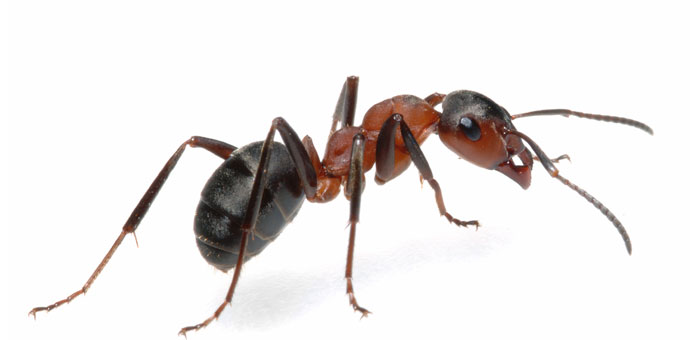
COMMON NAME: Carpenter ants
SCIENTIFIC NAME: Camponotusspp.
CLASS/ORDER/FAMILY: Insecta/Hymenoptera/Formicidae
METAMORPHOSIS: Complete
INTRODUCTION. The black carpenter ant, Camponotus pennsylvanicus(DeGreer), is a native species and the common species in the east. These ants get their common name from their habit of hollowing out galleries in pieces of wood for nesting purposes. This nesting habit can result in structural damage. Carpenter ants are found throughout the United States.
RECOGNITION.Workers polymorphic, large (1/8-1/2" or 3.5-13 mm) but vary greatly in size; queens about 1/2-5/8" (13-17 mm) long. Color black, combinations of red and black, or completely red or brown. Antenna 12-segmented, without a club. Thoraxlacks spines, profile evenly roundedon upper side. Pedicel 1-segmented. Gaster withanal opening round, surrounded by circlet of hairs.Stinger absent. Workers capable of emitting a strong formic acid odor. Camponotus pennsylvanicuswith workers about 1/4-1/2 (6-13 mm) long and completely black except top of gaster with long, pale yellowish hairs pressed against its surface. Camponotus modocwith workers about 1/4-1/2" (5-11 mm) long, dull black with reddish legs and with golden hairs covering abdomen. Queens up to 5/8+“(17+ mm) long. Although carpenter ants do not sting, their bites can be quite painful, especially when they inject formic acid into the wound.
BIOLOGY. Black carpenter ant colonies are of moderate size, usually containing over 3,000 workers (up to 10-15,000 including satellite nests) when maturity is reached in about 3 to 6 years. There is usually only one functional, wingless queen per colony. Swarmers appear from May until August in the East. Mating typically occurs during swarming. The males die shortly after mating. The inseminated females break off their wings and seek a nest site. The first clutch of eggs numbers 9-16. They hatch in 2-5 weeks, depending on the species and temperature. The queen feeds her first clutch primarily by metabolizing her body fat and flight muscles. The hook-shaped larvae go through 4 instars in 2-3 weeks. The prepupal and pupal stages last 2-4 weeks. The queen must assist the emerging adults in freeing themselves from their cocoons. Developmental time (egg to adult) for workers takes 6-12 weeks. Workers are polymorphic, with majors, minors (minims) and intermediates present.
CONTROL. For an established infestation, a thorough perimeter treatment of a nonrepellent pesticide is highly effective in eliminating the ant problem. If a satellite colony is just moving in or has recently moved in, then a spot treatment of the exterior area of the structure where the ants are active with a nonrepellent pesticide may be sufficient to eliminate the ants.
HABITS. Most carpenter ant species establish their first nest in decayed wood and later expand or enlarge this into sound wood. Inside, nests are located in wood (preferably softened by fungus rot), in insulation, and/or in wall voids. Workers are a nuisance when out searching for food but are destructive to timbers utilized for nesting activities. Outside, nests are typically located in rotting fence posts, stumps, old firewood, dead portions of standing trees, and under stones or fallen logs. Outside is the usual location of the parent colony, where the queen, eggs, and young are located. In mid-summer, satellite nests, which contain workers, mature larvae, and pupae, are established either outside or indoors. Carpenter ants feed primarily on insect honeydew, plant and fruit juices, insects, and other arthropods. Inside, they will also feed on sweets, eggs, meats, cakes, and grease. The workers forage for distances of up to 300 feet (91.4m) from the nest. They typically enter buildings around door and window frames, eaves, plumbing and utility lines, and shrub and tree branches in contact with the building. Although some workers are active during the day, most activity is from dusk till dawn, with peak activity between 10 pm and 2 am. The trail between the parent and satellite nest is usually about 1/4-13/16" (6-20 mm) wide and is kept clear of vegetation and debris. It usually follows contours but typically will cut across lawns.


